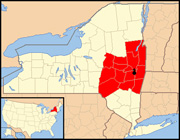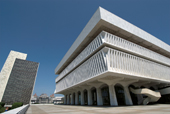The distribution of state capitals in U.S. cities has long been an endless source of fascination for foreign visitors.
Most countries in the rest of the world wait until a city to prove its "capital" (adjective) potential to become a "capital" (the noun) of something. America had no time for this. As a result, the capital of California isn't Los Angeles but Sacramento; the capital of Florida isn't Miami but Tallahassee; the capital of Illinois isn't Chicago but Springfield. And the capital of New York isn't New York City but Albany.
Truth be told, when that decision was taken in 1797, Albany had everything going for it: it was conveniently centric, it was the oldest surviving settlement from the original thirteen colonies, the longest continuously chartered city in the United States, and, perhaps more importantly, the other alternative was Kingston and that had just been burned down by the British. So it was decided that Albany was the least problematic spot to host the capital. And it's because of that decision that Albany is a very illuminating spot for any traveler expecting a complete New York experience.

Visiting Albany is sort of like going backstage during a rock concert -- you can see all the intricate, hard work that makes that New York City magic possible taking place here, in this quiet, serious-minded home of 95,000. The Big Apple may be its own animal, but it's hard to deny its connection of the state's history
As the New York's capital, Albany hosts the state's institutions (don't miss the New York State Capitol) and stores a good deal of its fascinating history. So it's only natural to give its museums and historical sites top priority over the other typical activities one can do in the city (surprisingly, getting married seems to be a New York favorite). If planned carefully, an immersion to the New York State Museum and the New York State Archives can be a perspective-changing eye-opener.
This usually goes very well with a side dish of the more locally-oriented but equally riveting Destroyer Escort Historical Museum (inside the USS Slater, one of the few warships that practically gets first-class war veteran treatment), the Pruyn House (one of the first Dutch settlements, which will illustrate just how much New York City owes to its Dutch origins) and the revealing Shaker Heritage Society (the best place to learn about the Shakers, whose weight on American culture for the past couple centuries may come as a shock).
There is more to Albany than its intimate connection with New York City. So many things have happened in both the city and the county of the same name -- the ultimate American song, Yankee Doodle, was penned in nearby Crailo, the Declaration of Independence was first read in New York at the corner of State and Broadway -- that leaving it without first checking its many historical sites would be a fatal mistake.

There's the archeological site at Fort Orange, where many pieces from New York's Dutch colonial past have been retrieved including parts of actual houses. There's the Harmony Mills cotton mill complex, the world's biggest when it opened in 1872.
There's the Philip Schuyler mansion, a brick home dating back to 1761 where the Revolutionary War general and later U.S. senator used to live and which you can now visit much like George Washington used to. Those less into American history and more into human history also have room in the same area -- the mansion is located in the impressive Schuyler Flatts district which shows remains of 6,000 years of human history in the area, collected from the relevant digs that took place in the 1970's.
Lovers of the fine arts can also visit the late Gothic monuments that's St. Peter's Episcopal Church, first erected in 1717, then destroyed by a fire and promptly reconstructed, then torn down again to make room for a new church which in turn was demolished to erect the one we now know from 1860, combining elements from the previous 150 years.
Of course, 150 years mean nothing to buildings like the Watervliet Arsenal, the oldest continuously active arsenal in the U.S. Founded in 1813, it has produced artillery, gun tubes for cannons, mortars and tanks in for every war the American army has been into.